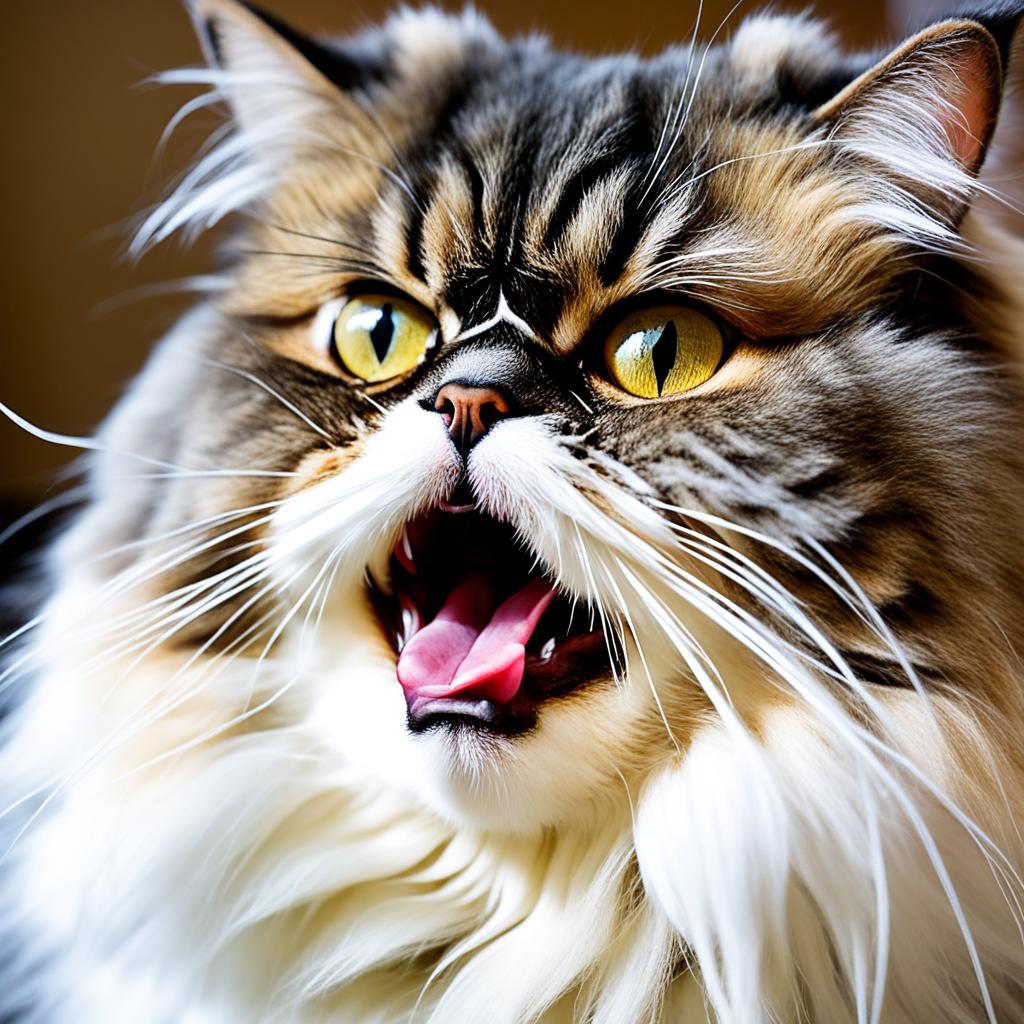Did you know that nearly 50% of Persian cats have breathing problems because of their flat faces? This is called brachycephalic syndrome. It comes from humans breeding these cats to look a certain way. Because of their squished faces, these cats find it hard to breathe.
Persian cats with severe brachycephalic syndrome face big challenges in breathing. They have small nostrils that make it tough to get enough air when breathing in. Also, their soft palates are too long, partly blocking their airways. Add to that a tiny windpipe and turned-out voice box flaps, and it’s very hard for these cats to breathe well.
Both International Cat Care and the British Veterinary Association are worried. They’re concerned about the suffering these cats go through because of the way they’re bred.
Key Takeaways
- About 50% of Persian cats are affected by chronic respiratory issues.
- Brachycephalic syndrome results from selective breeding for aesthetic traits.
- Persian cats face difficulty breathing due to stenotic nares and elongated soft palates.
- Hypoplastic trachea and everted laryngeal saccules further impede airflow.
- International Cat Care and the British Veterinary Association have expressed ethical concerns.
Introduction to Brachycephalic Syndrome in Persian Cats

Brachycephalic syndrome causes many health problems for Persian cats because of their unique look. If you’re thinking about getting a Persian cat, it’s important to know about this condition.
Definition of Brachycephalic Syndrome
Brachycephalic syndrome mostly affects Persian, Himalayan, and Burmese cats. It’s due to breeding for a flat face, changing their skull shape. This change in their skull can lead to serious health problems for some cats.
Why Persian Cats Are Prone to This Condition
Persian Cat Breathing Difficulties shape from breeding for a flat face. This design change has led to breathing issues and other health problems. The breathing troubles also make dental, eye, and birthing issues more likely. It’s crucial to think about these challenges when breeding and caring for Persians.
Common Symptoms of Breathing Issues in Persian Cats

Finding out the symptoms of Persian Cat Respiratory Problems is key. It helps keep your cat healthy. Look out for various signs that may show your cat has trouble breathing.
Open-mouth Breathing
Open-mouth breathing is a clear sign something could be wrong. If your Persian cat breathes through its mouth while resting, it might have respiratory problems. This often happens because their nostrils are too narrow or due to blockages in the airway.
Noisy or Raspy Breathing
Noisy or raspy breathing means your cat could have Persian Cat Respiratory Problems. Listen for wheezing or snorting sounds. These noises point to a blockage in the nasal passages or throat. It gets louder when they’re active or stressed.
Snoring and Coughing
Respiratory problems can cause your Persian cat to snore or cough while sleeping. This happens because of a long soft palate and other body parts stopping air from flowing freely.
Watching for these signs can make you understand Persian Cat Breathing Tips. It can help you take steps to protect their respiratory health.
How Breeding Practices Contribute to Breathing Problems

Selective breeding greatly impacts Persian cats’ breathing issues. Breeding for the feline’s flat-faced look has made these problems worse. This choice has focused on looks, making health problems like brachycephalic traits more common.
Trend Towards Breeding Flat-faced Cats
The popularity of Persian cats with flat faces makes breeders select for extreme flatness. This decision has made cats’ breathing troubles more severe. Breeders choose what looks good, which can harm the cats’ health. This can lead to issues such as bad teeth and trouble breathing.
Ethical Concerns and Calls for Change
Now, more people are debating the ethics of breeding Persians for flat faces. Many vets and animal groups say this hurts the cats and their quality of life. They ask for breeding changes to lessen breathing problems in Persian cats. They want the focus on health and happiness, not just looks.
| Issue | Effect |
|---|---|
| Flat-faced Breeding | Increased brachycephalic traits, leading to severe breathing problems in Persian cats |
| Dental Misalignments | Pain and difficulty in eating |
| Airflow Obstruction | Chronic respiratory distress |
| Ethical Concerns | Calls for change in breeding practices to prioritize health |
As more people learn about these breeding problems, it’s crucial to look for answers. We need solutions for Persian cat breathing issues that care about the cats’ health more than their looks.
The Anatomy Behind Persian Cat Breathing Issues
It’s important to know that Persian cats have unique features that cause breathing problems. They may have narrow nostrils, a long soft palate, and other issues. These make it hard for Persian cats to breathe properly, leading to serious health issues. Each issue plays a part in making breathing difficult for them.
Stenotic Nares
Stenotic nares, or narrow nostrils, limit how much air Persian cats can breathe in. This makes them breathe using their mouth more than their nose. It’s a challenge for them, showing that they might have breathing problems.
Elongated Soft Palate
The long soft palate in Persian cats also causes trouble. It blocks the airway, making it hard for them to breathe smoothly. This often leads to noisy breathing and might cause coughing or snoring. All of these make it even harder for the cat to get enough air.
Hypoplastic Trachea and Everted Laryngeal Saccules
A narrow windpipe, or hypoplastic trachea, is another issue Persian cats face. This limits the air going to their lungs, affecting their breathing. Too much airway pressure can also turn tissue in their larynx outward. This makes breathing even more difficult. Together, these problems mean Persian cats need special care to help them breathe better.




